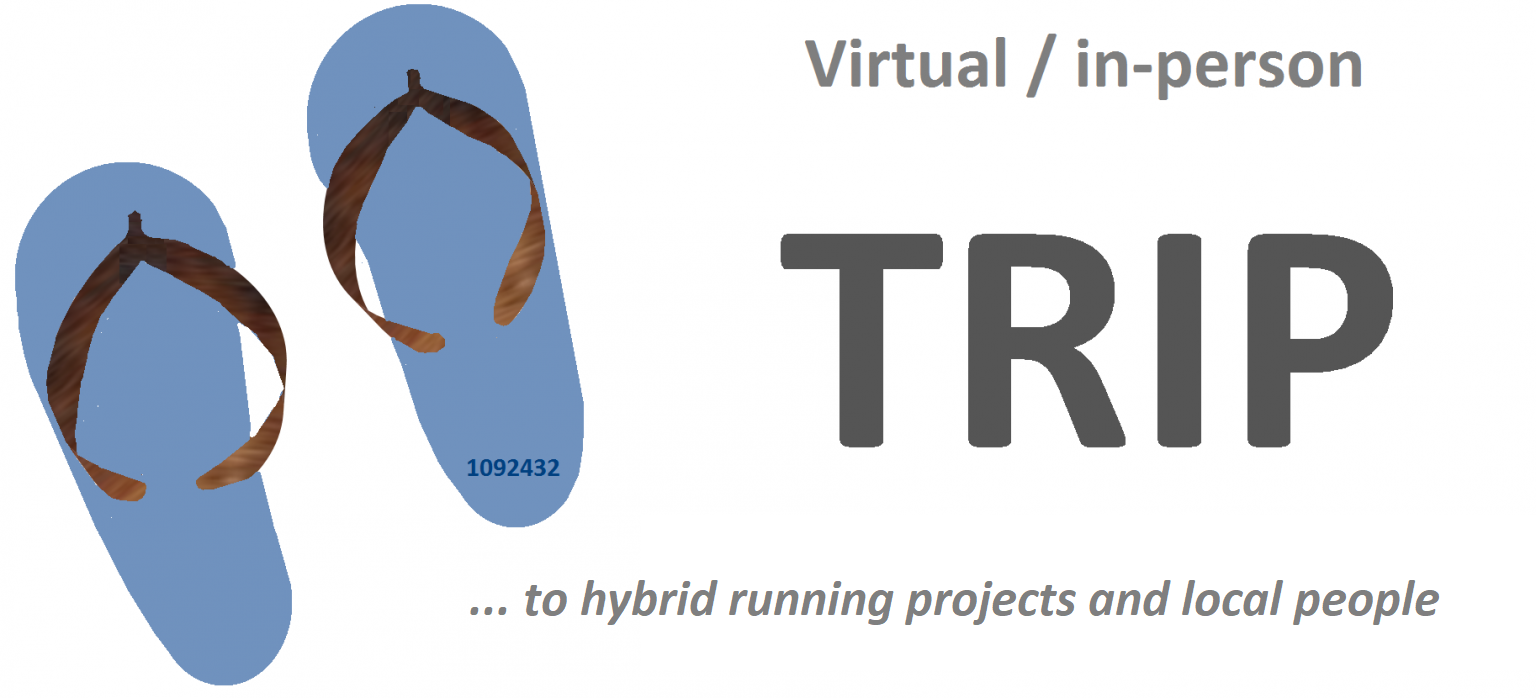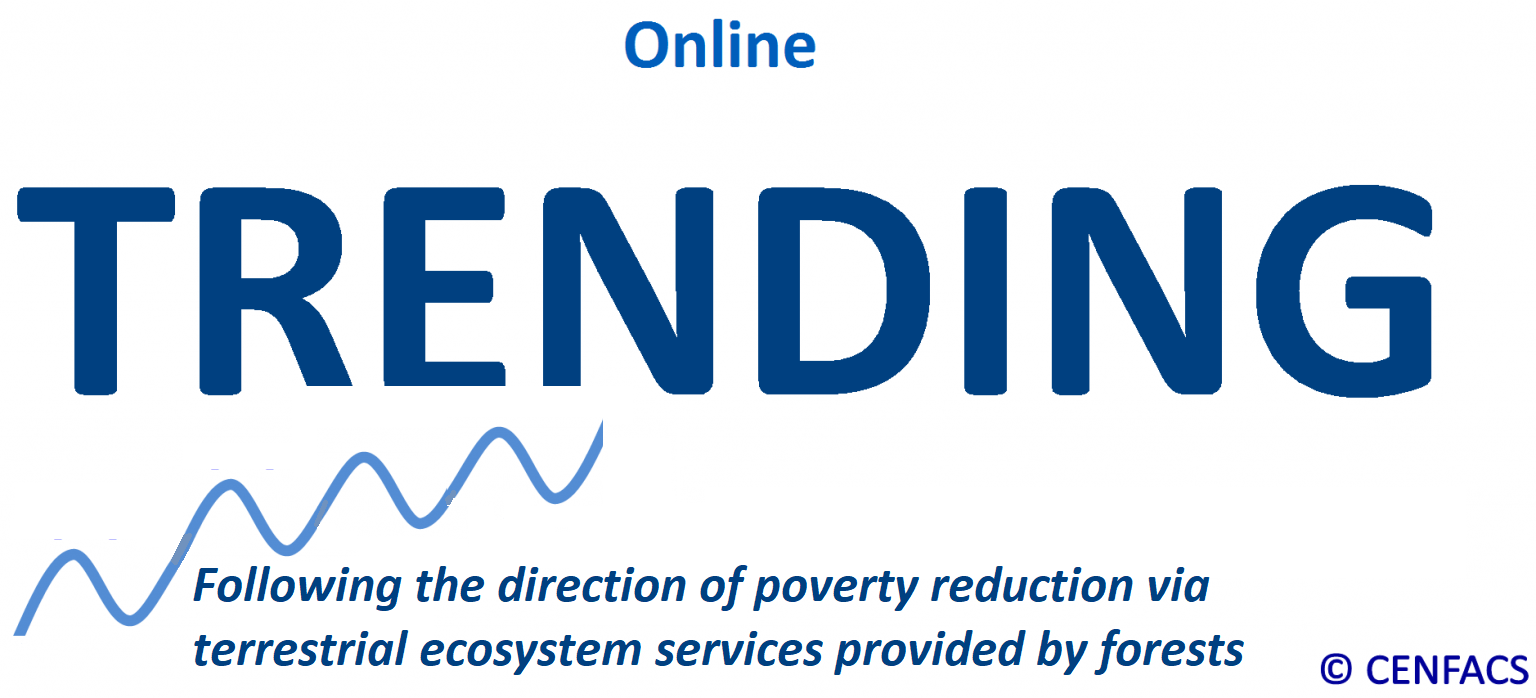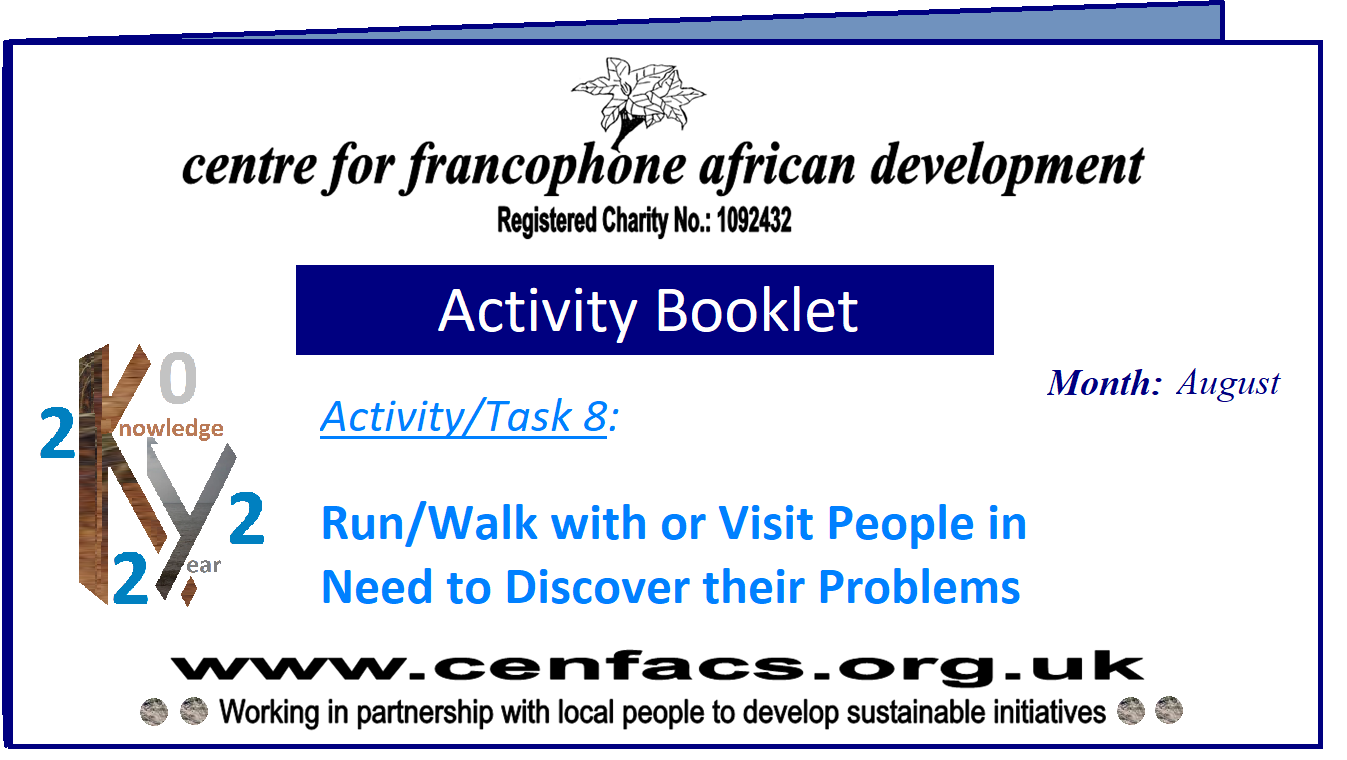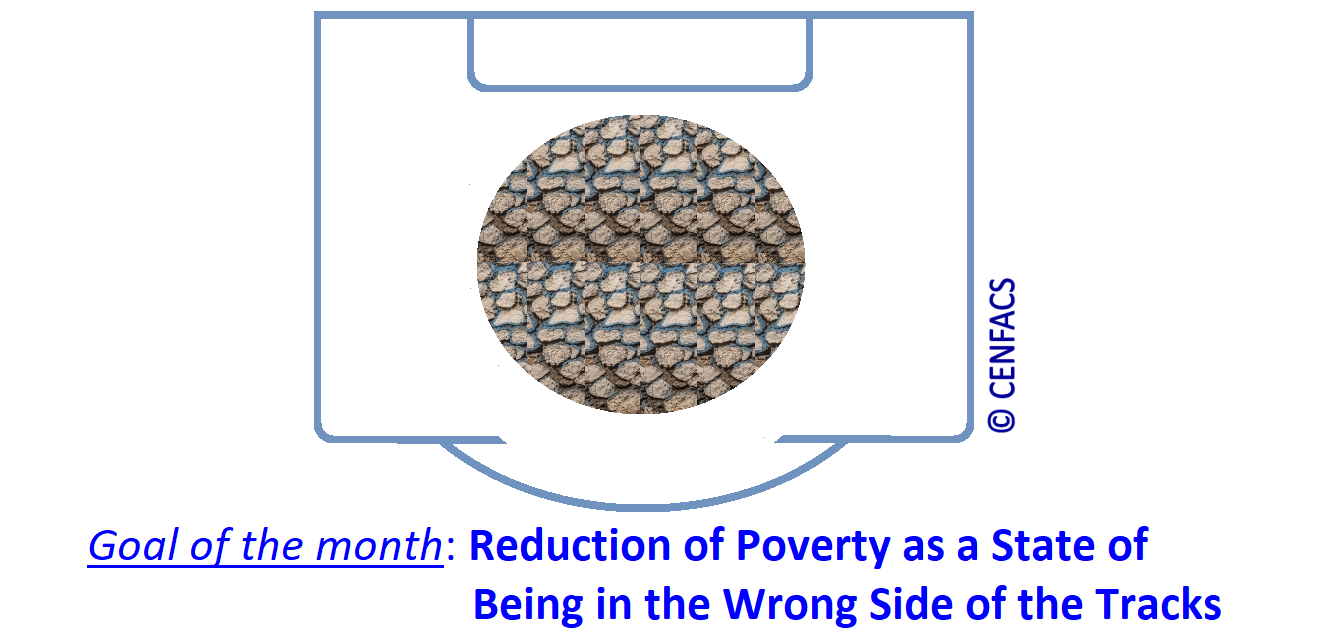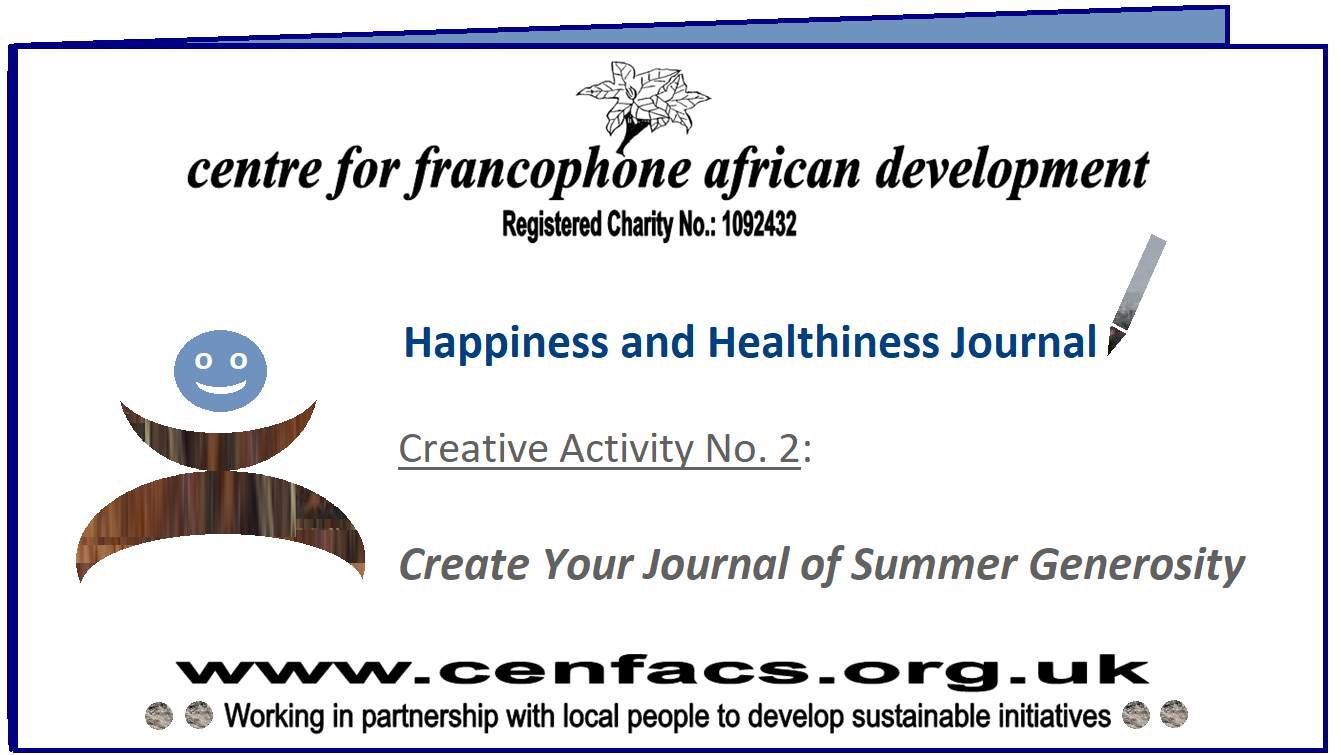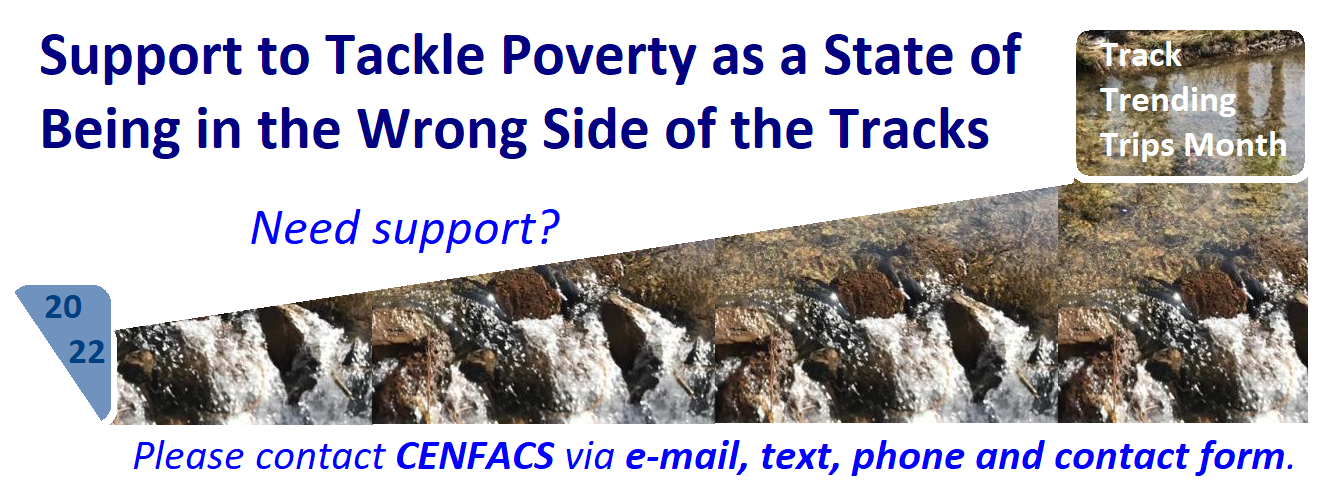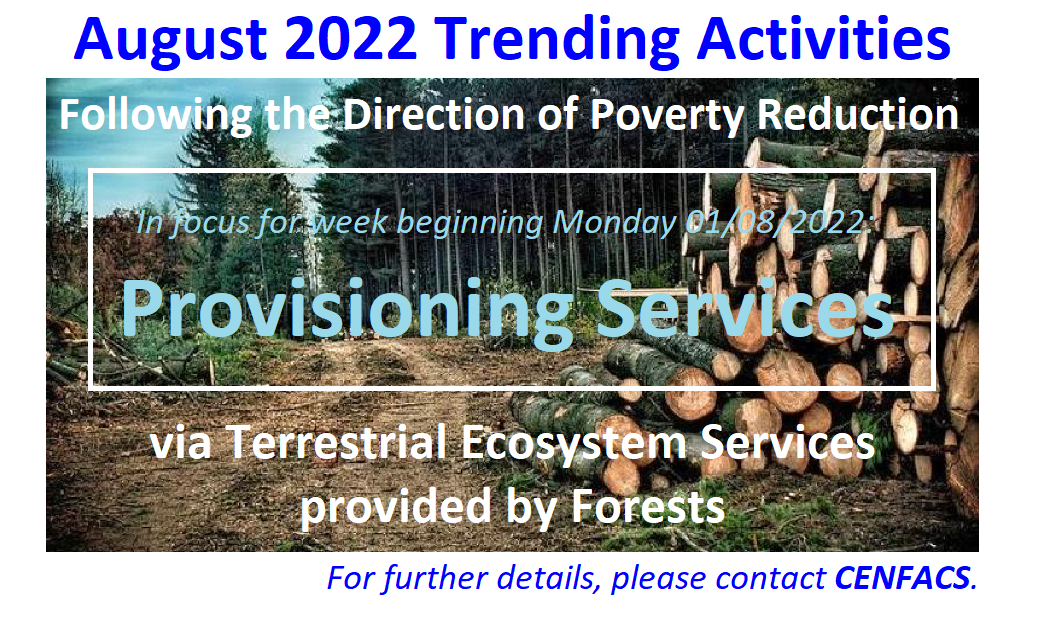Welcome to CENFACS’ Online Diary!
03 August 2022
Post No. 259
The Week’s Contents
• Track, Trending and Trip in a Summer of Rising Costs of Living, Changing Climate and Lingering Effects of the Coronavirus
• Activity/Task 8 of the Knowledge (‘K’) Year and Project: Run/Walk with or Visit the People in Need to Discover their Problems
• Goal of the Month: Reduction of Poverty as a State of Being in the Wrong Side of the Tracks
… And much more!
Key Messages
• Track, Trending and Trip in a Summer of Rising Costs of Living, Changing Climate and Lingering Effects of the Coronavirus
August is CENFACS’ Track, Trending and Trip month. What do we mean by that? We mean that we are on the track of poverty reduction, we walk to meet those in need and we follow the direction of poverty reduction. Let us briefly explain these key words or activities of the month (i.e., track, trending and trip).
• • On the Track of poverty reduction
We do Track at CENFACS as we think that every one of us can undertake basic physical activity of running or racing to help reduce poverty. To basically run or race, one does not need to be part of field event. For those who cannot in-person run, they can do it virtually or online. Our project known as Run to Reduce Poverty is designed to meet that end.
This Summer, we are going to do Tracking while taking into account the treble context of rising costs of living, changing climate and lingering effects of the coronavirus.
• • Trips or Walks to CENFACS’ projects
August is also the month during which we carry out some Trips to our projects. We visit our projects all over the year, but August is the time we highlight this. We do a short journey to one of the places in need. It is the month of the year we walk again and reach out to the need, to the people, communities, organisations and livelihoods in need.
This Summer, we are going to undertake both Virtual or In-person Trips depending on the circumstances prone to the rising costs of living, changing climate and lingering effects of the coronavirus.
• • Trendy development
We thirdly deal with Trending in August as we spend time looking at what is popular at CENFACS in the context of poverty reduction as well as what is the current general movement or tendency in poverty reduction. This is what what we can call Trendy Development; that is a development process following the latest fashions in terms of poverty reduction.
Trending in Poverty Reduction helps us to follow the direction of poverty reduction work. This August we are going to follow this direction or tendency of poverty (or poverty reduction) via terrestrial ecosystem services provided by forests.
Forest ecosystem services can help reduce poverty, particularly through food, pollution control, tourism, shelter, etc. Forests contribute or enhance climate aspects of sustainable development. We are therefore interested in the specific benefits of forests to poverty reduction.
We are going to follow this direction in-person. Where we have problem to follow it in-person, we shall do it via online, video, phone, screen and digital technological means of communication and on papers (print).
• • Track, Trending and Trips in a Summer of Rising Costs of Living, Changing Climate and Lingering Effects of the Coronavirus
The contexts of this summer are of rising costs of living, changing climate and the lingering effects of the coronavirus. We are going to integrate these factors into the theme of Summer when carrying out these three activities of August 2022: Track, Trending and Trip.
More details about CENFACS’ Track, Trending and Trips month for this year is given under the Main Development section of this post.
• Activity/Task 8 of the Knowledge (‘K’) Year and Project: Run/Walk with or Visit the People in Need to Discover their Problems
As part of CENFACS’ Knowledge Year and Project, the activity or task to be carried out for this month is to undertake the physical activity of running or walking with the people in need. In the process of running and/or walking, one can try to discover their problems and possibly think of the solutions to them.
Alternatively, one can in-person visit the people in need and try to find out through their visit the kind of problems they are experiencing and discuss with them the types of solutions they would like to see. The following examples can help illustrate these activities.
• • Examples of August 2022 Innovative Knowledge-based Sharing Activities
To put into practice CENFACS’ Knowledge Year and Project and of the month of Track, Trip and Trending; one can proceed with either of the following Knowledge-based Sharing Activities:
Activity 8.1: COVID-19 Secure Run 2.5 miles (nearly 4 km) with people in need to create user-generated information opportunity and to learn about their problems
Activity 8.2: Undertake Virtual or In-person Visits or Tours of 3 knowledge-based projects or activities; projects or activities based on facts, information and skills acquired through experience or education, and which support people during this time of rising costs of living
Activity 8.3: Carry out online search to find 6 Trends in poverty reduction for projects that are based on the knowledge or practical understanding of needs; projects that use knowledge-based economy to support people to navigate their way out of poverty.
The above three examples of Knowledge-based Activities are our way of linking our ‘K’ Year/Project and the month of Track, Trip and Trending together.
These run, walk and visit can also be done virtually if there are problems to conduct them in-person. For virtual run, walk and visit; it is expected that the two parties (that is, CENFACS or those acting on behalf of CENFACS and the people in need) will have the means to effectively communicate in order to discover the problems that these people face and the solutions they expect.
The above if the activity or task for the ‘K’ Year/Project for those who are interested in carrying it out. For those who want any clarification of any aspects of the activity or task, they can contact CENFACS.
• Goal of the Month: Reduction of Poverty as a State of Being in the Wrong Side of the Tracks
In order to deal with with this goal, we are going to try to understand the type of poverty is trying to tackle and work with the community on the goal itself.
• • Understanding poverty as a state of being in the wrong side of the tracks
The area where people live can create or exacerbate the condition of being poor or disadvantaged. People can be poor because they live in a poor or disadvantaged urban or rural area. Likewise, poverty can be exacerbated because someone lives in a poor or disadvantaged ward.
• • • What is a disadvantaged area?
A disadvantaged area could be an area without infrastructures, amenities, technologies and facilities to help to stop poverty to happen or to reduce poverty if it happens.
• • Working with the community to reduce poverty as a state of being in the wrong side of the tracks
During this month of August 2022, CENFACS shall be working with the community to help tackle poverty as a state or condition of being in the wrong side of the tracks.
So, working toward this goal can help to reduce the different types of hardship experienced by the members of our community where they live or if it happens that they are in the wrong side of the tracks.
Although this is a goal for August 2022 only, it can however be part of any efforts to reduce and or end poverty linked to a state or condition of being in the wrong side of the tracks.
• • Who are those in the wrong side of the tracks?
They could be those powerless, disadvantaged and vulnerable living in a ward of pronounced deprivation in well-being, lacking opportunities and infrastructures. They could also be those who are bearing the brunt of the rising costs of living, changing climate and lingering effects of the coronavirus.
The above is our poverty reduction goal for this month, which we are asking to our audiences and supporters to help or promote.
Extra Messages
• Happiness and Healthiness Journal, Creative Activity No. 2: Create Your Journal of Summer Generosity
Generosity is one of the six predictors of happiness and healthiness. One can create a journal about what they are giving (or gave) or are receiving (or received) unselfishly.
Like last Summer, this Summer is tough for many ordinary people and families since the cost-of-living crisis can only make things difficult for them. Many of these poor people and families are looking for unselfish help and support.
For those who would manage to give or receive this generous support; they can create a journal for the things, organisations and people who have been unselfishly supportive to their happiness and healthiness during this Summer 2022.
They can record their thoughts, feelings and experiences in relation to the generous support they have received or given. They can share with the community their experience of happy and healthy generous support. This can be recorded in their journal and be shared by the end of Summer 2022.
To share the contents of their happiness and healthiness journal relating to generous support, and help build a better Summer holiday experience; they can contact CENFACS.
• Record your Summer Telling Moments to Report Back
Whether one has a Summer break or is working over this Summer, it is always a good idea to record your memorable moments or just what you are doing.
After Summer, we often ask people or the community to report their Summer experience back. If you record what you are doing this Summer, after Summer it will be easier to share what you may judge is a shareable part of your Summer experience or story.
If you decide to record your Summer activities or experiences, please do not forget to take photos and pictures, make a video, record your voice, podcast, etc. It is also useful to write down dates, places and names of people involved in your projects or experiences. You can plan the way you want to report back whether you want to use words or numbers or information graphics (e.g. tables or graphs, figures, etc.).
Before including people around you in your recorded experience, please take care of Data Protection Regulations. This extra care will help to protect yourself and others. If necessary, please check the policy on handling people’s information and data.
Reporting back your experiences can sometimes inspire others, especially if your experiences contain poverty-relieving elements. Sometimes what you may think is not important in your life experience could be very useful or even life-saving for others in the community.
We hope you will seriously take our message of recording to report back.
Thank you!
• Summer 2022 Humanitarian Appeal Projects
The 2022 Edition of our Summer Humanitarian Appeal has now been completed and is ready for support. We have added to CENFACS’ Distress-free Life from the Cost-of-living Crisis in Africa the other four remaining projects making this appeal. The addition includes:
√ All Gifts for All Poor
√ International Networking and Protection against the Cost-of-living Crisis
√ Iconic Young Carer
√ ELCLASSICO International.
To support and or enquire about these appeal projects, please contact CENFACS.
Message in French (Message en français)
Objectif du mois : Réduction de la pauvreté en tant qu’état d’être du mauvais côté des pistes
Afin de faire face à cet objectif, nous allons essayer de comprendre ce type de pauvreté et de travailler avec la communauté à ce sujet.
Comprendre la pauvreté comme un état d’être du mauvais côté des pistes
La région où vivent les gens peut créer ou exacerber la situation de pauvreté ou de désavantage. Les gens peuvent être pauvres parce qu’ils vivent dans une zone urbaine ou rurale pauvre ou défavorisée. De même, la pauvreté peut être exacerbée parce qu’une personne vit dans une zone pauvre ou défavorisée.
Qu’est-ce qu’une zone défavorisée ?
Une zone défavorisée pourrait être une zone dépourvue d’infrastructures, d’équipements, de technologies et d’installations pour aider à mettre fin à la pauvreté ou à réduire la pauvreté si elle se produisait.
Travailler avec la communauté pour réduire la pauvreté en tant qu’état d’être du mauvais côté des pistes
Au cours de ce mois d’août 2022, le CENFACS travaillera avec la communauté pour aider à lutter contre la pauvreté en tant qu’état ou condition d’être du mauvais côté des pistes.
Ainsi, travailler vers cet objectif peut aider à réduire les différents types de difficultés vécues par les membres de notre communauté où ils vivent ou s’il arrive qu’ils soient du mauvais côté des pistes.
Bien qu’il s’agisse d’un objectif pour août 2022 seulement, il peut toutefois faire partie de tout effort visant à réduire et/ou à mettre fin à la pauvreté liée à un état ou à une condition d’être du mauvais côté des pistes.
Qui sont ceux ou celles qui se trouvent du mauvais côté des pistes?
Il peut s’agir de personnes impuissantes, défavorisées et vulnérables vivant dans un quartier de privation prononcée de bien-être, manquant d’opportunités et d’infrastructures.
Ce qui précède est notre objectif de réduction de la pauvreté pour ce mois-ci, que nous demandons à nos audiences et à nos sympathisants d’aider ou de promouvoir.
Main Development
• Track, Trending and Trip in a Summer of Rising Costs of Living, Changing Climate and Lingering Effects of the Coronavirus
Our thematic and working model of Summer of Happiness and Healthiness in a Summer of Costs of Living, Changing Climate and Lingering Effects of the Coronavirus will continue this month through the three activities of…
1) TRACK to help reduce poverty
2) Virtual or In-person TRIPS to Projects and locals
3) TRENDING in poverty reduction by following the direction of poverty reduction via forest ecosystem services.
The following headings contain the elements making this model:
∝ Track, Trip and Trending 2022 Activities
∝ August 2022 Trending Activities/Programme
∝ What is in focus from week beginning 01/08/2022: Provisioning Services Provided by Forest Ecosystems.
Let us uncover what is inside these headings.
• • Track, Trip and Trending 2022 Activities
• • • Track to help reduce poverty in a Summer of Costs of Living, Changing Climate and Lingering Effects of the Coronavirus
This is delivered through the project Run to Reduce Poverty, Gaming to Reduce Poverty and Vote your African Manager of Poverty Reduction. These are All-year Round Projects or Triple Value Initiatives.
However, because of the weather conditions (sunshine) and nature of August (holiday time for many of our supporters) we put a particular emphasis on the Run aspects of these all-year round projects, over this month. One can do physical run out and indoor while bearing in mind the lingering effects of the coronavirus and rising temperatures.
We expect those who sign up to the Run element to take actions and run it by themselves while following to letter any health and safety rules (e.g. Protection against the lingering effects of the coronavirus) relating to this element. After summer or at any convenient time before the end of the year, they can report back to us.
• • • Virtual or In-person TRIPS to Projects and Locals in a Summer of Rising Costs of Living, Changing Climate and Lingering Effects of the Coronavirus
This is the second aspect or part of work over the month of August at CENFACS. We expect and advise our supporters to visit some of our projects and initiatives whether in the UK or in Africa during and around the month of August.
For those who cannot in-person or physically visit projects on the grounds, arrangements can be made between the prospective visitors and the organisations to be visited so that they can organise a virtual trip, tour or viewing.
This requires that the visitors and visiting organisations have the technology that enables this virtual tour to happen. If this is possible we expect and advise our supporters to virtually visit some of projects and initiatives whether in the UK or in Africa during and around the month of August.
Because we are also talking about Trip to the needs in a changing climate, our Trip this year will be to see how climate change affects local people and local needs as well.
Trip to the need and project includes some of the experiences undertaken by CENFACS All in Development Volunteers through field work involvements and project visits, to reach out to unreached, underserved and unserved people and communities, particularly those living in remote areas of Africa. It is the kind of experiences that we recommend to future invertebrate and vertebrate volunteers to have and report back in September or after.
These trips also help us to check if we are on the right track at helping to reduce poverty and at tracking our records for the work on the ground.
Because the theme of trending for this Summer is about Forest Ecosystem Services, we are going to link Trip to the need on the ground in terms of what services terrestrial forest ecosystem provides to reduce poverty and enhance sustainable development.
• • • TRENDING in poverty reduction by following the direction of poverty reduction via forest ecosystem services
Sustainable development does not need to be trendy, but we can follow the latest fashions in sustainable development and poverty reduction.
This August, we are dealing with Trending in poverty reduction by following the direction of poverty reduction via forest ecosystem services and their capacity in lifting people out poverty. We mean by that we are following the direction of poverty reduction via terrestrial ecosystem services provided by forests.
In order to make sense of our trending activity, let us briefly explain forest ecosystem services and their relationship with poverty reduction.
• • • • Basic understanding of Forest Ecosystem Services
Before understanding forest ecosystem services, let us first try to define forest ecosystems.
Our definition forest ecosystems come from the website ‘sincereforests.eu’ (1), which states that
“A forest ecosystem can be defined at a range of scales. It is a dynamic complex of plant, animal and micro-organism communities and their abiotic environment interacting as a functional unit, where trees are a key component of the system. Humans, with their cultural, economic and environmental needs are an integral part of many forest ecosystems”.
On the same website, one can find the following explanation of forest ecosystem services:
“Forest ecosystem services (FES) are forests’ contribution to people: forest goods and services that bring direct or indirect economic, materialistic, physiological, psychological, emotional or social advantage to the human population”.
Indeed, forests contribute a lot to human lives. According to the World Bank (2),
“They [forests] are home to some of the poorest and most vulnerable people… Forests are an important safety net for rural populations in times of economic or agricultural stress”.
In the context of our activity of looking at FES, we are specifically interested in how these services are helping people to reduce and possibly end poverty. This does not mean that the other contributions or benefits of FES are irrelevant. It just means that we are going to focus on what FES are doing to people in need in order for them to escape from poverty and hardships. And if FES can do something about poverty, this could suggest that there could be relationship between FES and poverty reduction.
• • • • Possible relationships between FES and poverty reduction
There are various relations between FES and poverty reduction if one considers each service making the FES as well as the whole FES. It is possible to identify these relationships if one takes into account the well known classification of FES in terms of provisioning, regulating, cultural and supporting services. Let us look at these probable relationships via this classification.
• • • • • The relationship between the provisioning service of forest ecosystems and poverty reduction
The provisioning service that forest ecosystems provide via food, water, medicine and raw materials can help people to come out poverty. Historically, many people came out of poverty thanks to food, water and medicine from forest ecosystems. According to the Food and Agriculture Organisation of the United Nations (3),
“Water, food, wood and other goods are some of the material benefits people obtain from ecosystems called provisioning services”.
• • • • • The relationship between the regulating service of forest ecosystems and poverty reduction
The regulating service that includes the treatment of waste water and the control of pollution and flood for example can help to reduce sanitation poverty and health poverty. It can help as well improve the quality of air and safe drinking water.
• • • • • The relationship between the cultural service of forest ecosystems and poverty reduction
There are many cultural benefits that stem from forest ecosystems that contribute to the reduction of poverty. Among them, recreational, educational and tourist activities coming from forest ecosystems provide opportunities to reduce poverty if these activities involved the poor or include poverty reduction in their objectives or goals or even strategies.
• • • • • The relationship between the supporting service of forest ecosystems and poverty reduction
Forest ecosystems support poor people in many ways. One of the ways of supporting them is they provide home or shelter to homeless people. Forest dwellers who are homeless or without shelter can use forests as dwellings. Forest ecosystems can as well help to meet their spiritual, hygienic and toiletry needs.
The above indicates that there are areas whereby there could a link between FES and poverty reduction. In fact, where there is no forest and there is poverty, poverty could be hard to beat.
From what has being argued about the above mentioned relationships, we will be observing how FES are doing to hep reduce poverty and enhance sustainable development. We will be looking at the extent to which FES can be poverty reducer and sustainability enhancer.
So, we will be following the direction of poverty reduction via terrestrial ecosystem services provided by forests in a Summer of Rising Costs of Living, Changing Climate and Lingering Effects of the Coronavirus. This is what will be trending at CENFACS, as given below.
• • August 2022 Trending Activities/Programme
August 2022 Trending Activities or Programme will focus on commonly known four types of FES and how they can help reduce poverty and enhance sustainable development. These FES are: provisioning, regulating, cultural and supporting services. To follow them, we need a plan.
• • • August 2022 working plan about forest ecosystem services
The following is our August 2022 plan of work.
∝ Week Beginning Monday 01/08/2022; Trending: Provisioning Services provided by Forest Ecosystems
∝ Week Beginning Monday 08/08/2022; Trending: Regulating Services provided by Forest Ecosystems
∝ Week Beginning Monday 15/08/2022; Trending: Cultural Services provided by Forest Ecosystems
∝ Week Beginning Monday 22/08/2022; Trending: Supporting Services provided by Forest Ecosystems.
The rest of the days of the month (that is; from 29 to 31 August 2022) will be dedicated to monitoring and evaluation of August 2022 Trending Activities or Programme.
If you are interested in this trending programme, please share with us your experience or comments about it.
Further explanation about this August month’s activities can be obtained from CENFACS.
• • In Focus from Week Beginning 01/08/2022: Provisioning Services provided by Forest Ecosystems
Before explaining how we are going to follow the direction of poverty reduction here, let us first understand the provisioning services provided by forest ecosystems.
• • • Provisioning services provided by forest ecosystems
• • • • What are provisioning services?
There are many definitions about provisioning services provided by forest ecosystems. Most of these definitions tend to be similar. One of them comes from the website ‘biodiversity.fi’ (4) that states
“Provisioning services are tangible products that people obtain from ecosystems. These include food, water, raw materials, energy and genetic resources…Provisioning services are vital in the human economy and have often well-developed markets and valuation systems”.
Indeed, forest ecosystems furnish trees, other wood plants and natural resources. Forest ecosystems contain forest products such as wood, fruits, nuts, medicine, gums, etc. These products supply service to animals, birds and humans.
Concerning the provisioning services provided to humans, the latter feed themselves with food and freshwater given by forest ecosystems. What is important is not the question whether or not forest ecosystems supply services to humans. What is at stake here is about how these products can help to reduce poverty for those living in poverty. In order to know that these products are helping to reduce poverty, it is better to follow the direction of poverty via provisioning services provided by forest ecosystems.
• • • Following the direction of poverty reduction via provisioning services provided by forest ecosystems
Provisioning services provided by forest ecosystems do help to reduce poverty. Those who are gifted enough and live in the vicinity of forests, they have the opportunity, if they have permitted access, to have forest products to feed themselves, cure themselves from disease, to maintain their lifestyle, to have fresh water, etc. Those who live beyond the perimeter of forests can as well enjoy the provisioning services provided by forest ecosystems as long as transport of forest products allowed it or if they can afford to buy provisioning services traded in markets.
If that is the case, then it is possible to observe or following the journey of forest products and check how they are helping to reduce poverty. In this observation and journey, it is better to consider forest products as they come from forests. This way, one can better seize their impact on poverty reduction and on poor people.
The above is our trending work for this week; work which has already started.
To follow with us the direction of poverty reduction via terrestrial ecosystem services provided by forests, please contact CENFACS.
_________
• References
(1) https://sincereforests.eu/forests/glossary/ (accessed in August 2022)
(2) https://www.worldbank.org/en/topic/forests/brief/forests-poverty-reduction (accessed in August 2022)
(3) https://www.fao.org/ecosystem-services-biodiversity/background/provisioning-services/en/ (accessed in August 2022)
(4) https://www.biodiversity.fi/ecosystemservices/services/provisioning/ (accessed in August 2022)
_________
• Help CENFACS keep the Poverty Relief work going this year
We do our work on a very small budget and on a voluntary basis. Making a donation will show us you value our work and support CENFACS’ work, which is currently offered as a free service.
One could also consider a recurring donation to CENFACS in the future.
Donate to support CENFACS!
FOR ONLY £1, YOU CAN SUPPORT CENFACS AND CENFACS’ NOBLE CAUSES OF POVERTY REDUCTION.
JUST GO TO :Support Causes – (cenfacs.org.uk)
Thank you for visiting CENFACS website and reading this post.
Thank you as well to those who made or make comments about our weekly posts.
We look forward to receiving your regular visits and continuing support throughout 2022 and beyond.
With many thanks.

